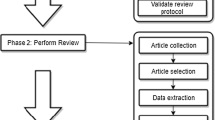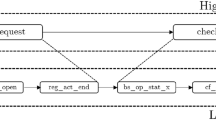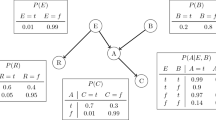Abstract
In this paper we propose a graph-based generic model able to uniformly represent semistructured data and their temporal aspects. In particular, we start from a generic and expressive model proposed in the database literature and consider in a formal and systematic way both valid time and transaction time, together with the set of temporal constraints needed to correctly manage the semantics of the represented time dimension. We then propose operations, which allow the incremental management of the proposed model satisfying the introduced temporal constraints. Moreover, we also deal with the possibility of managing together the two classical time dimensions of valid and transaction times, and formalize the set of constraints needed to correctly handle these temporal aspects together. Some examples taken from a medical scenario will be used to describe the introduced concepts.



















Similar content being viewed by others
Notes
Hereinafter, in the formulae we will use a prolog-like notation: each part of a node/edge label which could have any value in the formula is represented by the “do not care” symbol “_” in the corresponding position in the label.
In the following we will use the notation DD/MM/YY;HH:Mi (i.e., day, month, year, hour, and minute) for timestamps.
References
Abiteboul, S. (1997). Querying semi-structured data. In Proceedings of the international conference on database theory. Lecture notes in computer science (Vol. 1186, pp. 262–275).
Ali, K. A., & Pokorný, J. (2006). A comparison of XML-based temporal models. In E. Damiani, K. Yétongnon, R. Chbeir, & A. Dipanda (Eds.), SITIS. Lecture notes in computer science (Vol. 4879, pp. 339–350). Springer.
Allen, J. F. (1983). Maintaining knowledge about temporal intervals. Communications of the ACM, 26, 832–843.
Amagasa, T., Yoshikawa, M., & Uemura, S. (2000). A data model for temporal XML documents. In Database and expert systems applications, 11th international conference, DEXA 2000. Lecture notes in computer science (Vol. 1873, pp. 334–344). Berlin: Springer.
Amagasa, T., Yoshikawa, M., & Uemura, S. (2001). A bitemporal XML data model. In IPSJ SIGNotes dataBase systems (Vol. 125).
Amagasa, T., Yoshikawa, M., & Uemura, S. (2001). Realizing temporal XML repositories using temporal relational databases. In Proceedings of the third international symposium on cooperative database systems and applications (pp. 63–68). IEEE Computer Society.
Atzeni, P. (2002). Time: A coordinate for web site modelling. In Advances in databases and information systems, 6th east European conference, ADBIS 2002. Lecture notes in computer science (Vol. 2435, pp. 1–7). Berlin: Springer.
Böhlen, M. H., Snodgrass, R. T., & Soo, M. D. (1996). Coalescing in temporal databases. In VLDB’96, proceedings of 22th international conference on very large data bases (pp. 180–191), 3–6 September 1996, Mumbai (Bombay), India. Morgan Kaufmann.
Buneman, P., Davidson, S. B., Hillebrand, G. G., & Suciu, D. (1996). A query language and optimization techniques for unstructured data. In Proceedings of the 1996 ACM SIGMOD international conference on management of data (pp. 505–516). ACM Press.
Buneman, P., Khanna, S., Tajima, K., & Tan, W. C. (2002). Archiving scientific data. In SIGMOD conference.
Campo, M., & Vaisman, A. A. (2006). Consistency of temporal XML documents. In S. Amer-Yahia, Z. Bellahsene, E. Hunt, R. Unland, & J. X. Yu (Eds.), XSym. Lecture notes in computer science (Vol. 4156, pp. 31–45). Springer.
Ceri, S., Comai, S., Damiani, E., Fraternali, P., Paraboschi, S., & Tanca, L. (1999). XML-GL: A graphical language for querying and restructuring XML documents. Computer Network, 31 (11–16), 1171–1187.
Chawathe, S. S., Abiteboul, S., & Widom, J. (1998). Representing and querying changes in semistructured data. In Proceedings of the fourteenth international conference on data engineering (pp. 4–13). IEEE Computer Society.
Chawathe, S. S., Abiteboul, S., & Widom, J. (1999). Managing historical semistructured data. Theory and Practice of Object Systems, 5(3), 143–162.
Combi, C. (2000). Modeling temporal aspects of visual and textual objects in multimedia databases. In Proceedings of the seventh international symposium on temporal representation and reasoning (TIME-00) (pp. 59–68).
Combi, C., Degani, S., & Jensen, C. S. (2008). Capturing temporal constraints in temporal ER models. In Q. Li, S. Spaccapietra, E. S. K. Yu, & A. Olivé (Eds.), ER. Lecture notes in computer science (Vol. 5231, pp. 397–411). Springer.
Combi, C., Keravnou-Papailiou, E., & Shahar, Y. (2010). Temporal information systems in medicine (1st ed.). Springer.
Combi, C., Oliboni, B., & Quintarelli, E. (2004). A graph-based data model to represent transaction time in semistructured data. In Database and expert systems applications. Lecture notes in computer science (Vol. 3180, pp. 559–568). Berlin: Springer.
Combi, C., & Pozzi, G. (2006). Temporal representation and reasoning in medicine. Artificial Intelligence in Medicine, 38(2), 97–100.
Consens, M. P., & Mendelzon, A. O. (1990). Graphlog: A visual formalism for real life recursion. In Proceedings of the ninth ACM SIGACT-SIGMOD-SIGART symposium on principles of database systems (pp. 404–416). ACM Press.
Cormen, T. H., Leiserson, C. E., Rivest, R. L., & Stein, C. (2001). Introduction to algorithms (2nd ed.). MIT press.
Damiani, E., Oliboni, B., Quintarelli, E., & Tanca, L. (2003). Modeling semistructured data by using graph-based constraints. In OTM workshops proceedings. Lecture notes in computer science (pp. 20–21). Berlin: Springer.
Dyreson, C. (2001). Towards a temporal world-wide web: A transaction-time web server. In Proceedings of the Australian Database Conference (ADC ’01) (pp. 169–175).
Dyreson, C. E. (2001). Observing transaction-time semantics with TTXPath. In Proceedings of the 2nd international conference on Web Information Systems Engineering (WISE’01) (pp. 193–202).
Dyreson, C. E., Böhlen, M. H., & Jensen, C. S. (1999). Capturing and querying multiple aspects of semistructured data. In VLDB’99, proceedings of 25th international conference on very large data bases (pp. 290–301). Morgan Kaufmann.
Dyreson, C. E., & Grandi, F. (2009). Temporal XML. In L. Liu & M. T. Özsu (Eds.), Encyclopedia of database systems (pp. 3032–3035). Springer US.
Dyreson, C. E., Snodgrass, R. T., Currim, F., & Currim, S. (2006). Schema-mediated exchange of temporal XML data. In: D. W. Embley, A. Olivé, & S. Ram (Eds.), ER. Lecture notes in computer science (Vol. 4215, pp. 212–227). Springer.
Fernandez, M., Florescu, D., Kang, J., Levy, A., & Suciu, D. (1997). STRUDEL: A web site management system. In Proceedings of the ACM SIGMOD International Conference on Management of Data, SIGMOD Record (Vol. 26,2, pp. 549–552). ACM Press.
Garani, G. (2006). A generalised temporal algebra. Data and Knowledge Engineering, 57(3), 283–310.
Gibbons, R., et al. (1999). ACC/AHA/ACP-ASIM guidelines for the management of patients with chronic stable angina. Journal of American College of Cardiology, 33, 2092–2197.
Grandi, F., & Mandreoli, F. (2000). The Valid Web: An XML/XSL infrastructure for temporal management of web documents. In Advances in information systems, first international conference, ADVIS 2000. Lecture notes in computer science (Vol. 1909, pp. 294–303). Berlin: Springer.
Grandi, F., Mandreoli, F., & Tiberio, P. (2005). Temporal modelling and management of normative documents in XML format. Data & Knowledge Engineering, 54(3), 327–354.
Gregersen, H., & Jensen, C. S. (1999). Temporal entity-relationship models—a survey. IEEE Transactions on Knowledge and Data Engineering, 11(3), 464–497.
Hunter, A. (2002). Merging structured text using temporal knowledge. Knowledge and Data Engineering, 41(1), 29–66.
Jensen, C. S., Dyreson, C. E., et al. (1998). M. H. B.: The consensus glossary of temporal database concepts—february 1998 version. In Temporal databases: Research and practice. The book grow out of a Dagstuhl seminar, 23–27 June 1997. Lecture notes in computer science (Vol. 1399, pp. 367–405) Springer.
Jensen, C. S., & Snodgrass, R. (1999). Temporal data management. IEEE Transactions on Knowledge and Data Engineering, 11(1), 36–44.
Li, X., Liu, M., Ghafoor, A., & Sheu, P. C. Y. (2010). A pattern-based temporal XML query language. In L. Chen, P. Triantafillou, & T. Suel (Eds.), WISE. Lecture notes in computer science (Vol. 6488, pp. 428–441). Springer.
Mandreoli, F., Martoglia, R., & Ronchetti, E. (2006). Supporting temporal slicing in XML databases. In Y.E. Ioannidis, M. H. Scholl, J. W. Schmidt, F. Matthes, M. Hatzopoulos, K. Böhm, et al. (Eds.), EDBT. Lecture notes in computer science (Vol. 3896, pp. 295–312). Springer.
Manica, E., Dorneles, C. F., & de Matos Galante, R. (2010). Supporting temporal queries on XML Keyword Search Engines. JIDM, 1(3), 471–486.
Mendelzon, A., & Rizzolo, F. (2004). A.V.: Indexing temporal XML documents. In VLDB’04, proceedings of 30th international conference on very large data bases (pp. 216–227). Morgan Kaufmann.
Noh, S. Y., & Gadia, S. K. (2006). A comparison of two approaches to utilizing XML in parametric databases for temporal data. Information & Software Technology, 48(9), 807–819.
Noh, S. Y., Gadia, S. K., & Ma, S. (2008). An XML-based methodology for parametric temporal database model implementation. Journal of Systems and Software, 81(6), 929–948.
Oliboni, B., Quintarelli, E., & Tanca, L. (2001). Temporal aspects of semistructured data. In Proceedings of the eighth international symposium on temporal representation and reasoning (TIME-01) (pp. 119–127). IEEE Computer Society.
Papakonstantinou, Y., Garcia-Molina, H., & Widom, J. (1995). Object exchange across heterogeneous information sources. In Proceedings of the eleventh international conference on data engineering (pp. 251–260). IEEE Computer Society.
Paredaens, J., Peelman, P., & Tanca, L. (1995). G–Log: A declarative graphical query language. IEEE Transactions on Knowledge and Data Engineering, 7(3), 436–453.
Rizzolo, F., & Vaisman, A. A. (2008). Temporal XML: Modeling, indexing, and query processing. VLDB Journal, 17(5), 1179–1212.
Rosado, L. A., Márquez, A. P., & Gil, J. M. (2007). Managing branch versioning in versioned/temporal XML documents. In D. Barbosa, A. Bonifati, Z. Bellahsene, E. Hunt, & R. Unland (Eds.), XSym. Lecture notes in computer science (Vol. 4704, pp. 107–121). Springer.
Shoham, Y. (1987). Temporal logics in AI: Semantical and ontological considerations. Artificial Intelligence, 33(1), 89–104.
Snodgrass, R. T. (2000). Developing time-oriented database applications in SQL. Series in data management systems. Morgan Kaufmann.
Terenziani, P., & Snodgrass, R. T. (2004). Reconciling point-based and interval-based semantics in temporal relational databases: A treatment of the telic/atelic distinction. IEEE Transactions on Knowledge and Data Engineering, 16(5), 540–551.
Vaisman, A., Mendelzon, A. O., Molinari, E., & Tome, P. (2004). Temporal XML: Data model, query language and implementation. Technical Report. http://www.cs.toronto.edu/~avaisman/papers.html.
World Wide Web Consortium (2000). Document Object Model (DOM) level 2 core specification. http://www.w3C.org/TR/DOM-Level-2-Core/.
World Wide Web Consortium (1999). XML path language (XPath) version 1.0. http://www.w3.org/TR/xpath.html. W3C Reccomendation 16 November 1999.
Wang, F., & Zaniolo, C. (2002). Preserving and querying histories of XML-published relational databases. In Proceedings of the second international workshop on evolution and change in data management. Lecture notes in computer science (Vol. 1909, pp. 26–38). Berlin: Springer.
Wang, F., & Zaniolo, C. (2003). Publishing and querying the histories of archived relational databases in XML. In Proceedings of the 4th international conference on Web Information Systems Engineering (WISE 2003) (Vol. 1909, pp. 93–102). IEEE Computer Society.
Wang, F., & Zaniolo, C. (2004). XBiT: An XML-based bitemporal data model. In P. Atzeni, W. W. Chu, H. Lu, S. Zhou, & T. W. Ling (Eds.), ER. Lecture notes in computer science (Vol. 3288, pp. 810–824). Springer.
Wang, F., & Zaniolo, C. (2008). Temporal queries and version management in XML-based document archives. Data & Knowledge Engineering, 65(2), 304–324.
Wang, F., Zaniolo, C., & Zhou, X. (2008). ArchIS: An XML-based approach to transaction-time temporal database systems. The VLDB Journal, 7(6), 1445–1463.
Zhang, S., & Dyreson, C. E. (2002). Adding valid time to XPath. In Databases in networked information. Lecture notes in computer science (Vol. 2544, pp. 29–42).
Author information
Authors and Affiliations
Corresponding author
Rights and permissions
About this article
Cite this article
Combi, C., Oliboni, B. & Quintarelli, E. Modeling temporal dimensions of semistructured data. J Intell Inf Syst 38, 601–644 (2012). https://doi.org/10.1007/s10844-011-0170-7
Received:
Revised:
Accepted:
Published:
Issue Date:
DOI: https://doi.org/10.1007/s10844-011-0170-7




